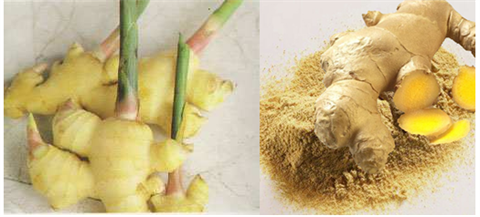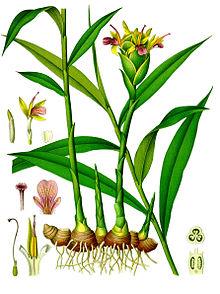ADRAK (GINGER)
Contents
- Etymology
- What is Ginger called in Various Indian Languages?
- The Plant Parts
- Origins of the Spice
- Ginger Compositions
- Medicinal Value – An Ayurvedic Perspective
- Vata-Pita-Kapha – The Actions of Three Doshas on Ginger
- Major Health Benefits
- Buying and Storage
- References
Etymology

The term ‘ginger’ has been derived from the Latin term ‘zingiberi’ and Greek ‘zingiberis’ which in turn have been derived from the Sanskrit term ‘singabera’. This etymological fact is also mentioned in the Oxford dictionary, where ‘sringam’ is spelt as ‘singabera’ meaning horn; the branched shape horn of ginger root resembling to that of an antler is the reason behind the name, as cited in the Oxford Dictionary. The scientific name of ginger is ‘Zingiber officinale Roscoe’.
The ancient Indian name of ginger is ‘aardrakam’ that refers to a fresh ginger; ‘adrak’ is the Hindi term of ginger. Similarly, ‘sunthi’ is the ancient name of dry ginger powder; ‘sunth’ is the Indian term of the same. Ardraka-Madya and Panam-Madya are the ancient names of ginger meaning ginger-ale and ginger-alcohol respectively.
What is Ginger called in Various Indian Languages?
Ginger, in different languages is as follows -
|
Language |
Fresh |
Dried |
|
Sanskrit |
ardraka [आर्द्रक] |
sunthi [सुंठि] |
|
Hindi, Dogri |
adrakh [अदरख] |
sonth [सोंठ] |
|
Telugu |
allamu [అల్లము] |
shonti [శొంటి] |
|
Gujarati |
adu [આદું] |
sunth [સૂંઠ] |
|
Tamil |
ellam [எல்லம்] |
sunthi [சுண்டி] |
|
Punjabi |
adrak [ਅਦਰਕ] |
sund [ਸੂੰਡ] |
|
Bengali |
ada [আদা] |
|
|
Marathi |
ale [आले] |
sunth [सुंठ] |
|
Urdu |
adrak [ادرک] |
|
|
Kashmiri |
adrak [ادرک] |
shounth [شونٹھ] |
|
Pashto |
adrak [ادرک] |
sund [سونډ] |
|
Santali |
Ada, adhe |
sut |
The Plant Parts
Ginger is a tuberous horizontal perennial plant which is quite large in size having distinctive knots. Generally, a ginger plant stretches itself till around 90 cm up from the ground; the leaves are 15-30 cm in length and 2-3 cm in breadth. The stems which are branched in the underground are called rhizomes. Typical characteristics of the rhizomes are as follows –
- hardy and swollen,
- diameter 2.5 cm,
- white/yellow from inside, orange/grey-brown with age,
- both the leaves and rhizomes of a plant give fragrance when are cut/peeled,
- after the leafy portions are dried, the rhizomes are dug out from the soil and sold in the market as fresh ginger.
Origins of the Spice
Ginger plant and its usage have Asian origins and it bears great culinary and remedial significance. Although it has Indian origins, later it was introduced in China and since then both the nations have been utilizing ginger rhizomes as a popular spice and medicine. Sanskrit literature has innumerable references to ginger and it is believed that from here it later reached various European, Arabian and other nations of the world.
Ginger Composition
100 grams (also weighing 100 gm) fresh ginger is composed of the following nutrition –
|
NUTRIENTS |
||||
|
Water |
78.9 g |
|
Ash |
0.8 g |
|
Protein |
1.8 g |
|
Phytosterols |
15 mg |
|
Minerals |
1.2 g |
|
|
|
|
CALORIES |
||||
|
Total Calories |
80 |
|
Calories from Fats |
6.3 |
|
Calories from Carbohydrates |
68 |
|
Calories from Proteins |
5.1 |
|
CARBOHYDRATES |
||||
|
Total Carbohydrates |
18 g |
|
Sugar |
1.7 g |
|
Dietary Fibre |
2 g |
|
|
|
|
FATS AND FATTY ACID |
||||
|
Total Fat |
750 mg |
|
Polyunsaturated Fat |
154 mg |
|
Saturated Fat |
203 mg |
|
Omega-3 Fatty Acids |
34 mg |
|
Monounsaturated Fat |
154 mg |
|
Omega-6 Fatty Acids |
120 mg |
|
VITAMINS |
||||
|
Vitamin C |
5 mg |
|
Niacin |
750 mcg |
|
Vitamin E |
260 mcg |
|
Vitamin B6 |
160 mcg |
|
Vitamin K |
0.1 mcg |
|
Folate |
11 mcg |
|
Thiamin |
25 mcg |
|
Pantothenic Acid |
203 mcg |
|
Riboflavin |
34 mcg |
|
Choline |
28.8 mg |
|
MINERALS |
||||
|
Calcium |
16 mg |
|
Sodium |
13 mg |
|
Iron |
600 mcg |
|
Zinc |
340 mcg |
|
Magnesium |
43 mg |
|
Copper |
226 mcg |
|
Phosphorus |
34 mg |
|
Manganese |
229 mcg |
|
Potassium |
415 mg |
|
Selenium |
0.7 mcg |

Medicinal Value – An Ayurvedic Perspective
Since Vedic times the usage of ginger is widely prevalent and ginger has been given the stature of Maha-Aushadi i.e. the great medicine. In Ayurvedic terms, ginger reduces Vata and Kapha. It controls cough, cold and common flu. For cough and swellings, doctors recommend ginger along with honey. Consumption of ginger is beneficial for mind as it is sattvic in nature. Application of ginger paste on head during headache and on joint pains (rheumatism) gives magical results. A number of other diseases can be cured with the intake of this Maha-Aushadi including chest congestion, diarrhoea, cholera, stomachache, nervous diseases, vomiting, and nausea. Sage Vatsyayana, the renowned Indian author of Kama Sutra, has also recommended ginger as an aphrodisiac. Ayurvedic physicians also recommend ginger to pregnant woman to gain short term relief form vomiting tendency or nausea. In rare cases, powdered ginger may lead to certain types of heartburn or nausea.
In Ayurveda both fresh (wet) ginger and dry ginger are used as medicinal components in preparations like powders, decoctions, etc. On the basis of Ayurvedic chemistry the properties and actions of dry ginger (sunthi or sunth) are discussed as follows –
- Snigdha – oily, buttery (unctuous)
- Ushna Veerya – hot potency
- Katu Rasa – hot and pungent in taste and nature
- Madhura Vipaka – post metabolic sweet
- Laghupaaka – light on stomach and easy to digest
- Vata Hara and Kapha Hara – reduces the aggravation or vitiation of the two doshas i.e. Vata and Kapha (owing to its hot and pungent nature)
- Action on Dhatus (Tissues) – Wide array of actions on tissue metabolism
- Vrishya or aphrodisiac – an element that increases sexual potency
Vata-Pita-Kapha – The Actions of Three Doshas on Ginger
The properties of ginger are contrary to the aggressive properties of Vata and Kapha. Vata is said to upset the digestive tracts; ginger has the properties to combat excess Vata present in the gastrointestinal tract and normalize the digestive functions. Stomach diseases, intestinal disorders and many secondary manifested conditions (owing to slothful stomach and lower stomach metabolism rate) can be cured with the adequate usage of ginger as part of ayurvedic medicines.
Actually, the concept of balanced metabolism has been explained well in the Ayurvedic literature. As explained, the upper gut (stomach) is the fire zone (extremely hot) and for rhythmic life activities the heat in the fire zone needs to be preserved. The disproportionate Vata or Kapha (cold elements) always stands as a threat for the fire elements in the gut. Dry ginger has the quality of refurbishing the balance in the fire zone, bringing back the right metabolism. The post metabolism conversion, the hot and pungent taste of dry ginger into a sweeter one simply checks and regulates the hot nature of Pita.
Ginger components, coming in direct contact with the stomach and tissues generates lubrication owing to the natural unctuousness in ginger. The hot and protective nature of ginger protects the interior of the body. The unctuous element also helps in checking degeneration and dry Vayu efficiently. By rekindling (oiling) fire in the stomach, ginger also helps in proper digestion. Dry ginger engenders the functional integrity of the three elements – fire, air, and water – required for metabolism and gut digestion at initial levels. Again, the functionality of the three elements are separately described as follows –
- Water (Kledaka kapha) – Before Pitta (fire) action is initiated, the initial lubrication of food and its perfect setting is provided by Kledaka Kapha.
- Fire (Pachaka Pitta) – Before the food undergoes absorption, Pachaka Pitta acts upon the food, makes the food simple and subtle enough for digestion.
- Air (Samana Vata) – Samana Vata receives the food and enables it for mobilization, digestion, absorption, and transportation. It keeps the fire balanced and controlled before performing the above steps.

Major Health Benefits
Major health benefits of ginger are –
- Ulcer check – Ginger generates mucus secretion and helps control unwanted holes inside the stomach and aggravation of ulcers.
- Calming troubled stomach – The carminative properties provide relief from gastric problems and bloating stomach.
- Relief from sour throat – Ginger juice stimulates the secretion of mucus and thus gives relieves from cough, itchy and sour throat.
- Used as anti-inflammation - Chemical components of ginger check inflammation by controlling biosynthesis of prostaglandins. Its anti-inflammatory properties can effectively treat osteoarthritis, rheumatoid arthritis and muscular disorders.
- Treatment of cold – Anti-fungal, anti-toxic, anti-viral properties of ginger effectively treat and prevent cold.
- Quick digestion – The enzymes present in the ginger augments protein levels in the food. Thus food is quickly digested; irregular cramps and diarrhea are also controlled.
- Helpful in nausea – Any type of nausea caused due to morning sickness, motion sickness, seasickness, etc. can be controlled. Again, side effects of chemotherapy can also be checked with ginger intake in a prescribed format.
- Lower cholesterol – Ginger prevents development of blood clots and also helps in checking cholesterol levels evidently.
- Prevention of colorectal cancer cells – Gingerols in ginger is responsible for its distinct flavour. Gingerols also help in controlling the growth of colorectal cancer cells.
Buying and Storage
Basically, there are two types of gingers, young (fresh) and mature (old). Mature ginger has tough skin which requires peeling. Fresh gingers, generally found in the Asian markets, have softer skin that doesn’t require peeling. It is always advisable to buy fresh gingers rather than the older ones. Fresh ginger is always superior in flavour with higher levels of gingerol and active protease. Fresh gingers are smooth, quite firm and easily mouldable. The shelf life of a fresh unpeeled ginger in a refrigerator is around three weeks; while in a freezer is around six months.
While buying ginger powder, it is always advisable to buy powder which is prepared from organically grown ginger. Ginger powder is stored in tightly sealed container of glass; when stored in a refrigerator it lasts till a year. Besides in powder form, gingers are consumed in many other forms, including candied, crystallized and pickled ginger.
http://www.hindubooks.org/sudheer_birodkar/india_contribution/prod.html
http://www.onlineremedies.in/2014/02/ginger.html
http://drraghuramys.wordpress.com/2013/01/03/properties-and-mode-of-action-of-dry-ginger-an-ayurvedic-perspective/
http://www.lassiwithlavina.com/foodieheavan/indian-ginger-tales/html
http://www.kew.org/science-conservation/plants-fungi/zingiber-officinale-ginger
http://www.swadeshi.co/product.aspx?id=23
http://www.indianmirror.com/ayurveda/indian-spices/ginger.html
http://gernot-katzers-spice-pages.com/engl/Zing_off.html
http://www.dharmaayurveda.com/article/2308.html
View/s: 23117 Comment/s: 0
